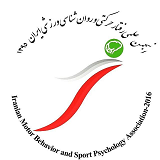Mon, Dec 22, 2025
[Archive]
Volume 2, Issue 2 (5-2020)
IJMCL 2020, 2(2): 15-23 |
Back to browse issues page
Download citation:
BibTeX | RIS | EndNote | Medlars | ProCite | Reference Manager | RefWorks
Send citation to:



BibTeX | RIS | EndNote | Medlars | ProCite | Reference Manager | RefWorks
Send citation to:
Rahmati Aran M, Dehghanizade J. (2020). Effect of Training on the Balance and Coordination of the Mentally Retarded Children. IJMCL. 2(2), 15-23. doi:10.29252/ijmcl.2.2.15
URL: http://ijmcl.com/article-1-54-en.html
URL: http://ijmcl.com/article-1-54-en.html
Assistant Professor of Motor Behavior, Faculty Member of Urmia University , jalal.dehghanizade@yahoo.com
Abstract: (5768 Views)
Background: The present research aims to consider the effects of a training on the static and dynamic balance and coordination of the educable mentally retarded children.
Method: In this semi-experimental study, 24 individuals were selected from amongst educable mentally retarded boy students with the calendar age of 6-9 years old who did not have any special illness and motion restriction. The participants were randomly divided into two identical control (n: 12) and experiment (n: 12) groups. The selected exercise program was performed for 8 weeks including three 60-minute sessions for each week. The subscales of the balance and coordination of the Lincoln-Oseretsky test were used to evaluate the participants’ balance and coordination in the pretest and posttest.
Results: The results showed that there was no significant difference between the two groups of control and experiment in pretest; whereas, a significant difference was observed in the static balance, dynamic balance and coordination between the pretest and posttest scores in the experiment group. The effect of Brailletonik training on balance and coordination was confirmed.
Conclusion: According to the findings, it seems that Brailletonik training can be a suitable intervention to improve the motor elements in retarded children.
Method: In this semi-experimental study, 24 individuals were selected from amongst educable mentally retarded boy students with the calendar age of 6-9 years old who did not have any special illness and motion restriction. The participants were randomly divided into two identical control (n: 12) and experiment (n: 12) groups. The selected exercise program was performed for 8 weeks including three 60-minute sessions for each week. The subscales of the balance and coordination of the Lincoln-Oseretsky test were used to evaluate the participants’ balance and coordination in the pretest and posttest.
Results: The results showed that there was no significant difference between the two groups of control and experiment in pretest; whereas, a significant difference was observed in the static balance, dynamic balance and coordination between the pretest and posttest scores in the experiment group. The effect of Brailletonik training on balance and coordination was confirmed.
Conclusion: According to the findings, it seems that Brailletonik training can be a suitable intervention to improve the motor elements in retarded children.
Type of Study: Original Article |
Subject:
1. Motor learning
Received: 2019/12/5 | Accepted: 2020/03/9
Received: 2019/12/5 | Accepted: 2020/03/9
References
1. Aghjani, M. (2015). The effect of a "Brailletonik" training course on the motor- perceptual abilities of the elementary first-grade boy students. M.A dissertation, Boo Ali Cina University.
2. Brown, T. (2019). Structural Validity of the Bruininks-Oseretsky Test of Motor Proficiency-Second Edition (BOT-2) Subscales and Composite Scales. Journal of Occupational Therapy, Schools, & Early Intervention, 1-31. [DOI:10.1080/19411243.2019.1590755]
3. Cairney, J., Hay, J., Faugh, B., Corna, L. M., & Flouris, A. (2006). Developmental coordination disorder, age, and play: A test of the divergence in activity-deficit with age hypothesis. Adapted Physical Activity Quarterly, 23, 261-276. [DOI:10.1123/apaq.23.3.261]
4. Carulla, L. S., Reed, G. M., VAEZ‐AZIZI, L. M., COOPER, S. A., LEAL, R. M., Bertelli, M., ... & Girimaji, S. C. (2011). Intellectual developmental disorders: towards a new name, definition, and framework for "mental retardation/intellectual disability" in ICD‐11. World Psychiatry, 10(3), 175-180. [DOI:10.1002/j.2051-5545.2011.tb00045.x]
5. Cratty, B. J. (1967). Social dimensions of physical activity. Englewood Cliffs, NJ: Prentice-Hall.
6. Dawson, P., & Guare, R. (2018). Executive skills in children and adolescents: A practical guide to assessment and intervention. Guilford Publications
7. Dehghanizade J, rahmati arani M, Heydari M. The Effect of Brailletonik Exercise on the Motor Skills of Educable Children with Intellectual Disability . JOEC. 2018; 18 (1) :85-96
8. Di Fabio, R. P., & Anderson, J. H. (1992). Effect of inaccurate visual and somatosensory input on human head movement and postural patterns during stance. Posture and Gait: Control Mechanisms, Portland University of Oregon, 1, 163-166.
9. Giagazoglou, P., Kokaridas, D., Sidiropoulou, M., Patsiaouras, A., Karra, C., & Neofotistou, K. (2013). Effects of a trampoline exercise intervention on motor performance and balance ability of children with intellectual disabilities. Research in developmental disabilities, 34(9), 2701-2707. [DOI:10.1016/j.ridd.2013.05.034]
10. Giagazoglou, P., Sidiropoulou, M., Mitsiou, M., Arabatzi, F., & Kellis, E. (2015). Can balance trampoline training promote motor coordination and balance performance in children with developmental coordination disorder? Research in developmental disabilities, 36, 13-19. [DOI:10.1016/j.ridd.2014.09.010]
11. Hicks, M. K., Wiggins, M., Crist, R. W., & Mood, F. M. (2001). Sex differences in grad three student's attitudes toward physical activity. Perceptual and motor skills, 93, 97-102. [DOI:10.2466/PMS.93.5.97-102]
12. Kishore, M. T., Udipi, G. A., & Seshadri, S. P. (2019). Clinical practice guidelines for assessment and management of intellectual disability. Indian Journal of Psychiatry, 61(8), 194. [DOI:10.4103/psychiatry.IndianJPsychiatry_507_18]
13. Leitschuh, C. A., & Dunn, J. M. (2001). Prediction of gross motor development quotient in young children prenatally exposed to Cocaine/Polydrugs. Adapted Physical Activity Quarterly, 18, 240-256. [DOI:10.1123/apaq.18.3.240]
14. Salari-Askar M, Zarezadeh M, Amiri-Khorasani M. (2014). Effect of Perceptual-motor Training on Dynamic Balance in Boyes Aged 11-14 Years with Mental Retarded. J Res Rehabil Sci, 10(1): 139-150.
15. Tavanapur, M. (2015). The effect of a "Brailletonik" training course on the motor- perceptual abilities of the elementary girl students. M.A dissertation, Boo Ali Cina University.
16. Venkadesan, R., & Finita., G. R. (2010). Motor development and postural control evaluation of children with sensorineural hearing loss: a review of three inexpensive assessment toolspbs, TGMD-2, and p-ctsib rajendran. Iranian Journal Child Neurology, 4(4), 7-12.
17. Vuijk, P. J., Hartman, E., Scherder, E., & Visscher, C. (2010). Motor performance of children with mild intellectual disability and borderline intellectual functioning. Journal of intellectual disability research, 54(11), 955-965. [DOI:10.1111/j.1365-2788.2010.01318.x]
18. Wouters, M., Evenhuis, H. M., & Hilgenkamp, T. I. (2019). Physical activity levels of children and adolescents with moderate‐to‐severe intellectual disability. Journal of Applied Research in Intellectual Disabilities, 32(1), 131-142. [DOI:10.1111/jar.12515]
19. Wrotniak, B. H., Epstein, L. H., Dorn, J. M., Jonses, K. E., & Kondilis, V. A. (2006). The relationship between motor proficiency and physical activity in children. Pediatrics, 118(6), 1758-1765. [DOI:10.1542/peds.2006-0742]
20. Wuang, Y. P., & Su, C. Y. (2009). Reliability and responsiveness of the Bruininks-Oseretsky Test of Motor Proficiency-in children with intellectual disability. Research in Developmental Disabilities, 30(5), 847-855. [DOI:10.1016/j.ridd.2008.12.002]
Send email to the article author
| Rights and Permissions | |
 |
This work is licensed under Attribution 4.0 International (CC BY 4.0). |












